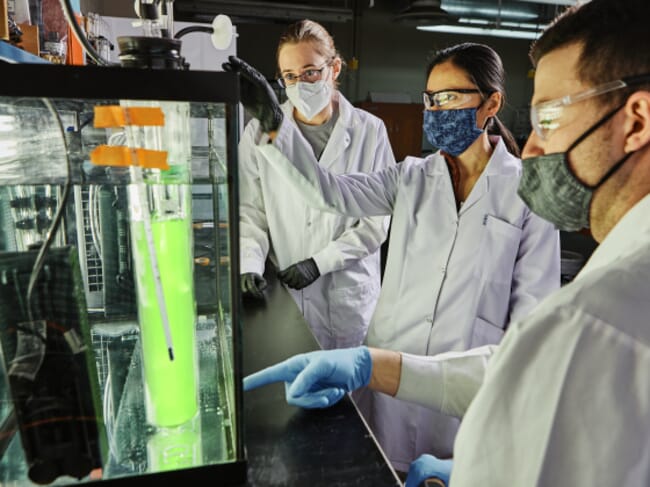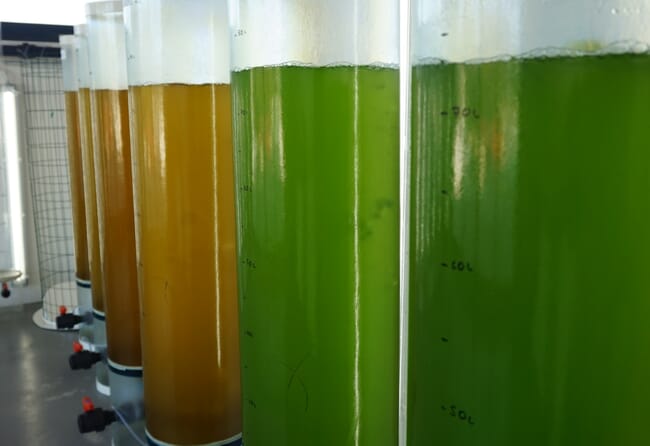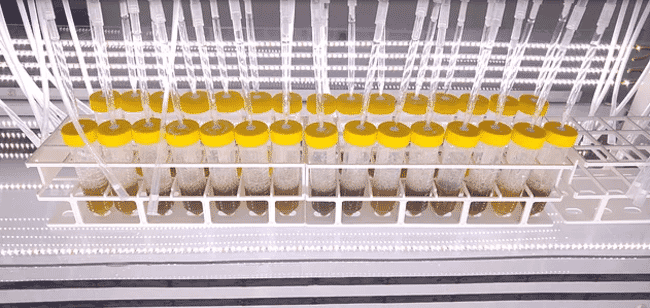
Building on more than a decade of MSU research on the topic, the three projects funded by the US Department of Energy and the National Science Foundation seek to advance understanding of how the tiny, plant-like microorganisms interact with their aquatic environment. That could lead to new ways of fine-tuning algae's ability to convert sunlight and carbon dioxide into natural oils that can then be refined into vehicle fuels, plastics and more, according to MSU researcher Robin Gerlach.
"It’s a topic that's really heating up right now," said Gerlach, professor in the Department of Chemical and Biological Engineering in MSU's Norm Asbjornson College of Engineering. "We're using a new generation of technologies to look at interactions in algae communities down to the level of single cells."
Gerlach is leading one of the projects, funded with $1.2 million from the NSF, that focuses on studying the relationship between algae and the other microbes they coexist with in the swimming pool-like tanks where algae are typically cultivated. In much the same way that human digestion relies on a community of bacteria found in the gut, growing evidence suggests that algae may also benefit from a so-called microbiome, Gerlach said.
By cultivating algae in the lab and then carefully introducing one or more strains of bacteria, the MSU researchers can study how the different organisms exchange nutrients. Lasers are used to pluck individual cells from sample dishes, and rapid genetic sequencing of the specimens can provide insight into how the bacteria and algae interact.
"What we're trying to do is build teams of microorganisms that have better capabilities together than each has individually," said Ross Carlson, professor in the chemical and biological engineering department, who is co-leading the project with Huyen Bui, assistant research professor in MSU’s Center for Biofilm Engineering, and CBE Director Matthew Fields. "Ultimately we hope to create something like a library of bacteria that we know interact with algae in productive ways," Carlson said.

© Algared
Together with a related project funded with $2 million from DOE, the studies focus on algae adapted to living with high concentrations of sodium bicarbonate, the primary ingredient in baking soda. MSU collaborators at University of Toledo discovered a strain of algae in eastern Washington’s Soap Lake, which contains high levels of the mineral. Subsequent research showed that the lake's unique environment allows the algae to metabolise carbon dioxide very efficiently while reducing competition from other microbes. According to Fields, alkaline systems with high pH like the lake can produce some of the highest carbon dioxide utilisation rates in nature, which was one of the driving factors to investigate the microorganisms under these conditions.
“These algae are definitely what you’d call extremophiles,” or organisms adapted to extreme environments, Carlson said. “We’re still learning how to fully leverage that.”
The DOE project — which includes collaborators at University of Toledo, University of North Carolina, Clemson University, Ford Motor Co. and industrial products manufacturer Sonoco — is focused on exploring several potential production improvements using the natural advantages of the unique algae, such as new ways of circulating water in cultivation tanks. Typically, large algae farms rely on supplemental carbon dioxide, such as from a fossil fuel-burning power plant, but the extremophile algae may be able to subsist wholly by pulling the gas from ambient air, according to Gerlach. That could enable algae production in more locations and reduce the need for costly infrastructure. Plus, production facilities could create the high alkalinity needed by adding sodium bicarbonate, a readily available and inexpensive mineral, he added.

Related research led by Sridhar Viamajala, professor of chemical engineering at University of Toledo, focuses on optimising algae production by reducing biochemical inefficiencies caused by the daily swing from sunlight-filled day to dark night. The study, funded by an additional $3.2 million from DOE, dovetails with the NSF project by seeking to improve algae production with cooperative communities of microbes as well as new cultivation practices.
The goal of the project, which includes collaborators at DOE’s Pacific Northwest National Laboratory and Hawaii-based biotech company Global Algae Innovations, is to boost productivity by 20 percent during fall and spring, according to Gerlach, who is co-leading the MSU portion of the project with Carlson and Fields. MSU is receiving roughly $1 million of the funds.
“These projects could make significant contributions to moving us toward a new bioeconomy where algae play a major role in making fuel, plastics and other products while helping us reduce carbon emissions,” Gerlach said. "We have instrumentation and expertise here at MSU that are really well suited to tackling that challenge.”




